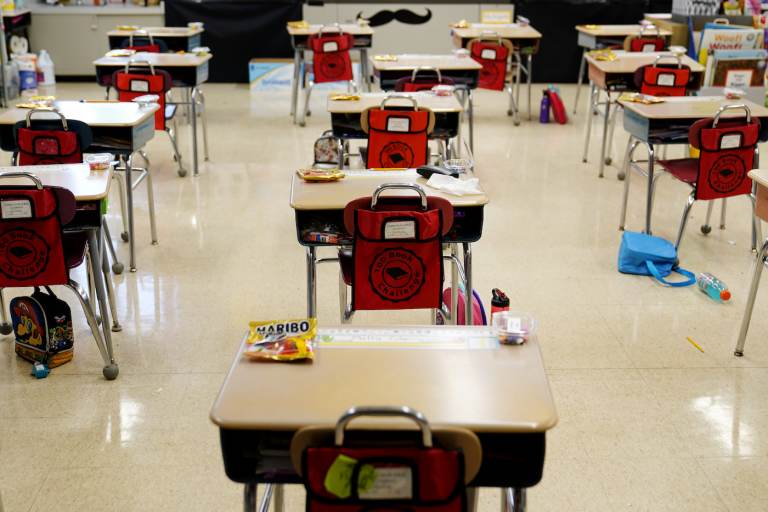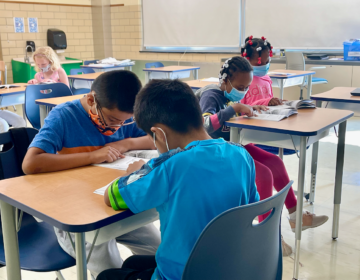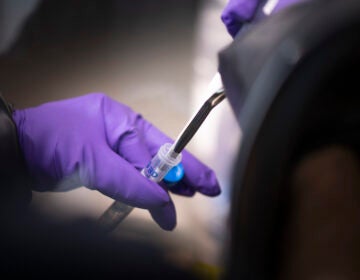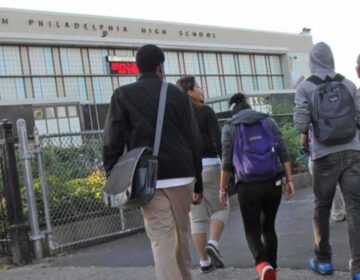Youngest Delaware students with special needs get new funding help
New funding requirements will help Delaware students younger than third grade get the extra help they need to start their school careers.

In this Thursday, March 11, 2021 file photo, desks are arranged in a classroom at an elementary school. (AP Photo/Matt Slocum, File)
Delaware’s youngest students with basic special education needs will now be able to get extra attention in their early school years thanks to a new funding formula approved by state lawmakers.
Funding for Delaware’s teachers is based on how many students are in a classroom. Generally, schools get funding for one teacher position for every 20 students in grades 4-12. One unit is funded for every 16.2 students in kindergarten through third grade.
Students who need special education help make up a separate count in a way that’s designed to provide them even more personal attention.
The state divides students who need special education into three categories: basic, intensive, or complex. Students needing complex special education require the highest level of instructional, behavioral, personal, or health support. Teachers helping those students typically work on a one-to-one or one-to-two ratio.
Those getting intensive special education need less help than the “complex” level. Teachers working with intensive-needs students typically have a teacher-to-student ratio that ranges from one-to-three to one-to-eight.
Students who need basic help have a teacher-to-student ratio of one teacher to eight students. But until now, that lower ratio only started in the fourth grade. Students younger than that who need basic special education did not get a lower student-to-teacher ratio.
Under legislation recently signed into law by Gov. John Carney, students from kindergarten through third grade will get the one-to-eight teacher-to-student ratio over the course of the next three years.
“We all know that early intervention is the key and resources are a must for our students to be successful, especially for our youngest learner,” said State Rep. Kim Williams, who worked for several years to get the change approved in the General Assembly.
It was a personal fight for Williams (D-New Castle), whose daughter Casey was developmentally delayed when she started pre-school in the Red Clay School District.
“She just recently graduated with her master’s at Emerson,” she said. “Early intervention is the key to identifying students early, and providing the resources in this bill is huge for decreasing the class sizes and just having the necessary support in the classroom.”
State Sen. Nicole Poore (D-New Castle) also had a personal drive behind her support of better help for younger students. Her son Nick was born nine weeks early and was diagnosed with cerebral palsy.
“I have a child with special needs. He’s complex, so he immediately got the attention that he needed,” Poore said. “Oftentimes we can’t see the attention that is needed for our young children. And so, to be able to have the opportunity to identify, and hopefully get them off of an IEP [Individualized Education Plan] in their middle school years, that’s progressive. That is progression in education, and it is also a cost savings in the long run.”
The ratio of basic special education students to teachers will gradually be lowered from 12.2 students per teacher this year to 10.2 students per teacher next year. The following year, the ratio will reach its permanent rate of one teacher to 8.4 students.
It’s expected that the one-to-8.4 ratio will cost the state and local districts more than $15 million in Fiscal Year 2024.

Get daily updates from WHYY News!
WHYY is your source for fact-based, in-depth journalism and information. As a nonprofit organization, we rely on financial support from readers like you. Please give today.







